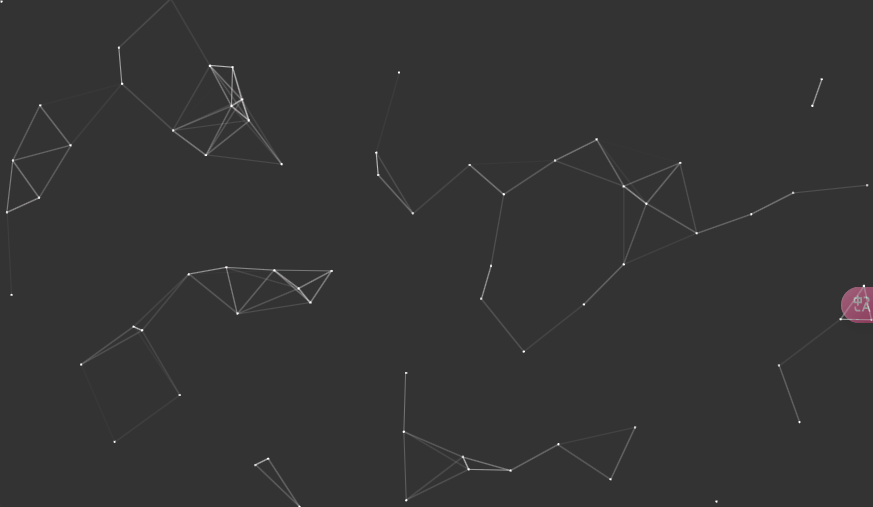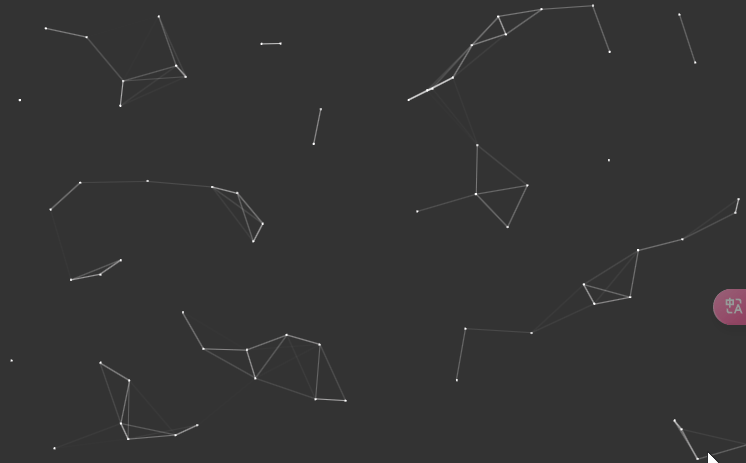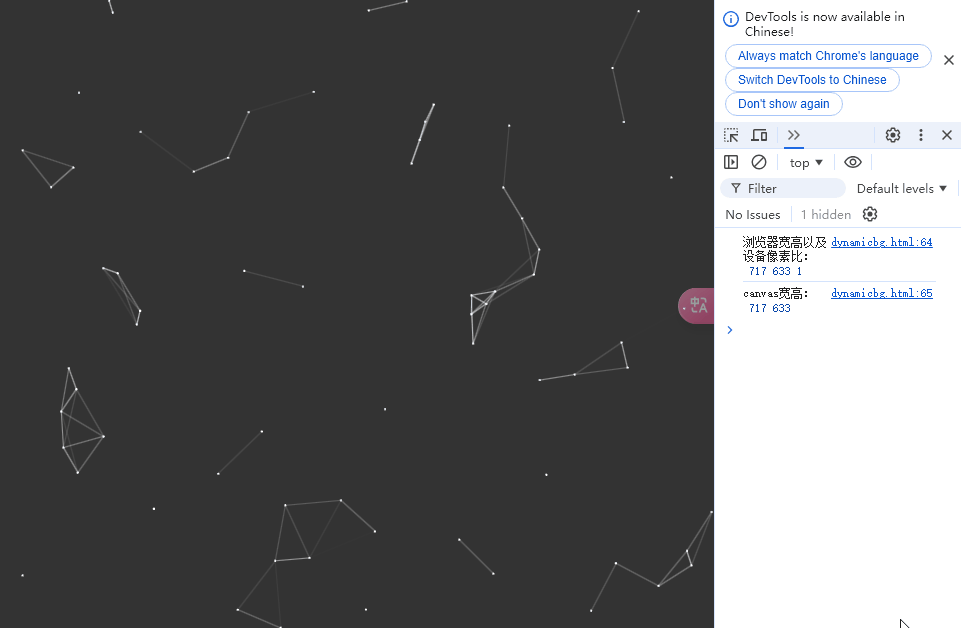今天用canvas来实现一个比较常见的动态背景,效果如下:

# 思路
实现思路就是在这个画布上随机生成一些点,然后让这些点存在一个数组里,让每一个点和后面的所有点连线,连线的透明度随着两点之间的距离增长而减少,如果超过一个阈值距离则不连线。
然后控制一下点的运动以及碰撞到边界进行反弹即可。
# 代码
<!DOCTYPE html>
<html lang="en">
<head>
<meta charset="UTF-8">
<meta name="viewport" content="width=device-width, initial-scale=1.0">
<title>Document</title>
<style>
canvas {
width: 100%;
height: 100%;
position: fixed;
top: 0;
left: 0;
}
</style>
</head>
<body>
<canvas id="canvas"></canvas>
</body>
<script src="./PointsAndLines.js"></script>
<script>
const canvas = document.getElementById('canvas');
canvas.width = window.innerWidth * devicePixelRatio;
canvas.height = window.innerHeight * devicePixelRatio;
console.log(window.innerWidth, window.innerHeight, devicePixelRatio)
console.log(canvas.width, canvas.height);
canvas.style.background = 'rgba(0, 0, 0, 0.8)';
const ctx = canvas.getContext('2d');
const pal = new PointsAndLines(70, canvas.width, canvas.height, 1, 0.5, canvas.width / 10);
pal.draw(ctx);
</script>
</html>
1
2
3
4
5
6
7
8
9
10
11
12
13
14
15
16
17
18
19
20
21
22
23
24
25
26
27
28
29
30
31
32
33
34
35
36
2
3
4
5
6
7
8
9
10
11
12
13
14
15
16
17
18
19
20
21
22
23
24
25
26
27
28
29
30
31
32
33
34
35
36
// PointsAndLines.js
class Point {
constructor(x, y, r, speed) {
this.x = x;
this.y = y;
this.r = r
this.xSpeed = (Math.random() > 0.5? speed : -speed) * Math.random();
this.ySpeed = (Math.random() > 0.5? speed : -speed) * Math.random();
}
draw(ctx) {
ctx.beginPath();
ctx.arc(this.x, this.y, this.r, 0, 2 * Math.PI);
ctx.fillStyle = "#fff";
ctx.fill();
}
}
class Line {
constructor(p1, p2, maxDis) {
this.p1 = p1;
this.p2 = p2;
this.maxDis = maxDis;
}
draw(ctx) {
ctx.beginPath();
ctx.moveTo(this.p1.x, this.p1.y);
ctx.lineTo(this.p2.x, this.p2.y);
// 勾股定理求两点之间的距离
const dis = Math.sqrt(Math.pow(this.p1.x - this.p2.x, 2) + Math.pow(this.p1.y - this.p2.y, 2));
if(dis > this.maxDis) return;
ctx.strokeStyle = `rgba(255, 255, 255, ${1 - dis / this.maxDis})`;
ctx.stroke();
}
}
class PointsAndLines {
// 生成点的数量、画布的宽、高、点的半径、移动的速度、连线距离阈值
constructor(pointNum, width, height, r, speed, maxDis = 200) {
this.points = new Array(pointNum).fill(0)
.map(() => new Point(Math.random() * width, Math.random() * height, r, speed))
this.preDrawDate = null;
this.width = width;
this.height = height;
this.maxDis = maxDis;
}
draw(ctx) {
ctx.clearRect(0, 0, this.width, this.height);
// 首次打开
if (!this.preDrawDate) {
this.points.forEach((point, index) => {
point.draw(ctx)
// 连线
for(let i = index + 1; i < this.points.length; i++) {
const line = new Line(point, this.points[i], this.maxDis);
line.draw(ctx)
}
})
} else {
this.points.forEach((point, index) => {
point.x += point.xSpeed;
point.y += point.ySpeed;
// 触碰边缘修改方向
if(point.x <= point.r || point.x >= this.width - point.r) point.xSpeed = -point.xSpeed;
if(point.y <= point.r || point.y >= this.height - point.r) point.ySpeed = -point.ySpeed;
point.draw(ctx)
// 连线
for(let i = index + 1; i < this.points.length; i++) {
const line = new Line(point, this.points[i], this.maxDis);
line.draw(ctx)
}
})
}
this.preDrawDate = new Date()
requestAnimationFrame(() => this.draw(ctx))
}
}
1
2
3
4
5
6
7
8
9
10
11
12
13
14
15
16
17
18
19
20
21
22
23
24
25
26
27
28
29
30
31
32
33
34
35
36
37
38
39
40
41
42
43
44
45
46
47
48
49
50
51
52
53
54
55
56
57
58
59
60
61
62
63
64
65
66
67
68
69
70
71
72
73
74
75
76
77
2
3
4
5
6
7
8
9
10
11
12
13
14
15
16
17
18
19
20
21
22
23
24
25
26
27
28
29
30
31
32
33
34
35
36
37
38
39
40
41
42
43
44
45
46
47
48
49
50
51
52
53
54
55
56
57
58
59
60
61
62
63
64
65
66
67
68
69
70
71
72
73
74
75
76
77
大概的实现方式就是这样,里面还有许多可以优化的地方,例如限制创建点的时候位置不能在边缘,更加自然的运动速度、方向以及连线算法等等,但作为一个demo练习目前已经可以了。
# 缩放问题
可能你会注意到我在设置canvas的宽高时乘上了一个devicePixelRatio:
canvas.width = window.innerWidth * devicePixelRatio;
canvas.height = window.innerHeight * devicePixelRatio;
1
2
2
这个devicePixelRatio是设备像素比,等于物理像素 / 逻辑像素,这里面的逻辑像素其实就是一般css样式或者js中拿到的像素,而物理则是设备本身的实际像素。
那么为什么要乘上这么一个值呢?我们不妨先把这个乘值去掉,看看会出现什么情况:

基于上面的公式,当你放大视口的时候,相当于拿着放大镜去看,devicePixelRatio会变大,window.innerWidth和window.innerHeight会变小,缩小视口则相反,而物理像素是始终不变的。
这样会导致逻辑像素与物理像素不统一,造成的后果就是显示的图片失真,那么我们要做的就是保持逻辑像素与物理像素的统一,这样无论你如何缩放视口,看到的内容都是一致的。
现在思路就比较清晰了,要让物理像素和逻辑像素保持一致,由于物理像素 = 逻辑像素 * 设备像素比,那么我把canvas的宽高也这么设置不就行了?所以就有了代码那一段,效果如下:

虽然gif比较模糊,但可以看到无论如何缩放,canvas都保持原样不会失真,并且宽高基本不变或者由于精度问题在很小的范围内变动。
